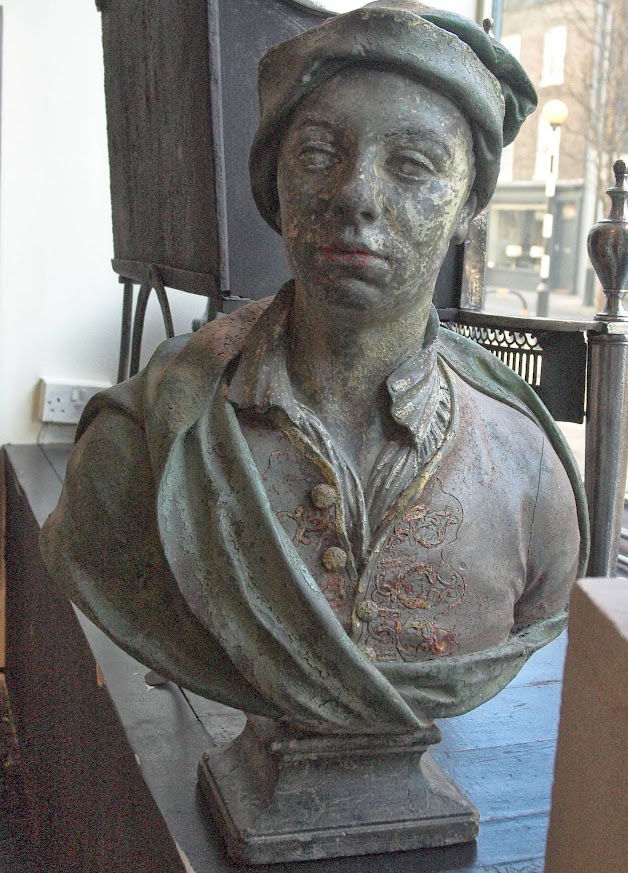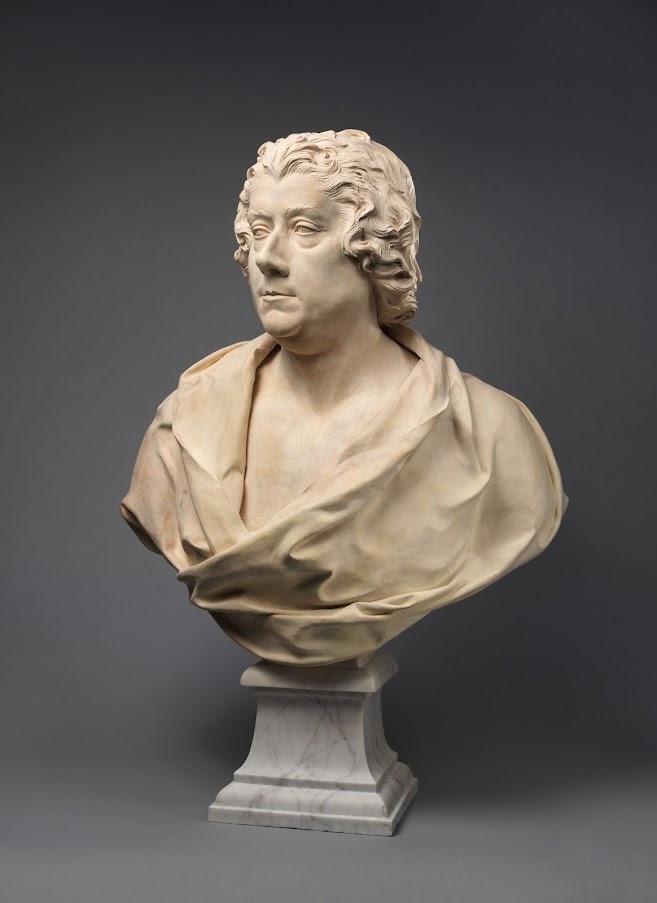A
Few Notes on the Birth and Early Career of Louis Francois Roubiliac.
This post updated July 2023.
The fairly recent acquisition by the Metropolitan Museum, New York of the terracotta bust of Senesino which is indisputably by Roubiliac demolishes my theory that the lead bust illustrated below is Senesino - it is much more likely to be Farinelli.
...............................
Roubiliac some notes on his early career.
Born,
31 August 1702, baptised in the Parish of St Nizier, Lyon, France,
godfather Jaques Colleymieux.
It
has so far seemed impossible to chart his early life. Some authors
have suggested that he worked under the sculptor Balthazar Permoser
in Dresden but so far there is no paper trail.
The
first actual mention of him as a sculptor that I can find is when he won second prize for
Daniel rescuing Susanna at the Academie Royale in Paris.
Notes -
On 5th
August 1730 it was agreed that submissions were completed and the
exhibition was judged on 26th
August. The process verbaux was signed by De Boullonge, C. Van Cleve,
Coustou L'aisne, Halle, de Boze,, Lemoyne l'aiasne, G.Coustou,
Rigaud, J.Christophe, Le Lorraine, Cazes, Dufuranne,
Bousseau, Verdot, Le Moyne le Jeune,
F.Lemoyne, Le Clerc,Restout, Meusnier, Du Change, De Chavanne,
Leblanc, Courtin, Desportes le fils, Masse, Thomassin, Saint Gelais,
Du Vivier, Huillot, De Lijen, Nicolas Tardieu and De Larmessin.
To have entered for the prize he would have to
had become an eleve or pupil of a member of the Academie Royale and
attached to a professional master who would provide a “Lettre de
Protection”.
In
1730 the Acadamie Directeur was Louis de Boulogne, the chanceleur was
van Cleve, and the recteur was Guillaume Coustou, there were twelve
professeurs at the Academie, with life classes for two hours a day
and occasional lectures. The process to obtain the prizes went
through four stages, a short list was prepared from the students
drawings, students were then asked to provide a sketch on a given
theme, if then chosen the student was locked into a room at the
Academie and asked to provide a sketch or relief of the proposed
work, and finally the works were put on public exhibition. Criticisms
were invited and then the Academie met in full session in order to
grant the prizes.
It
has been suggested in the past that Roubilliac was attached to one of
the Coustou brothers but I believe a much more likely candidate for his master is
Jaques
Bousseau (1681 -1761).
Notes
on Jaques Bousseau –
Born in Chavagnes-en-Paillers, France in 1681. Student of
Nicolas Costou and won the Prix de Rome in 1705. Died Valsain, Spain in 1740.
Bousseau worked in the studio of Nicholas Coustou, won the
prix de Rome in 1705, worked in Rome 1709 – 12, 1713 at the
Academie Royale.
1715 – 20 worked in the studio of Coyzevox, 1726
completed a statue started by Fremin and Bertrand, 1729, worked for
Cardinall de Noailles on his family chapel in Notre Dame de Paris.
1736 at the suggestion of Fremin he was invited to complete the
project to complete the sculptural decoration at the garden of La
Granja de San Ildefonsore for Philip V of Spain,
1738 he was
appointed Premier Sculpteur du Roi. 1761 died at Valsain, Spain.
Roubiliac
provided a letter of introduction to Jaques Bousseau for the English
painter Joseph Highmore (1692 - 1780) who was visiting Paris in 1734.
Bousseau
took Highmore to the Luxembourg on Saturday 8th June and
to the Tuilleries on Sunday 9th of June, on Monday 9th
he took him to his own studio and then to the Louvre. Whilst
circumstantial it suggests a certain intimacy between Roubiliac and
Bousseau. It also suggests that Roubiliac was already moving in the centre of
London's artistic circle by this time.
Highmore
also carried a letter of introduction to the sister of the artist
Hubert Gravelot whom he visited on 16th - 19th
June 1734. see Elizabeth Johnson, Joseph Highmore's Paris Journal,
1734, Walpole Society Journal, XLII 1970 pp. 61 -105.
Note.
Gravelot (1699 – 1773) born Hubert Francois Bourguignon, after a
peripatetic early life arrived in London 1732 or early 1733. (see
Hammelmann) to aid Claude du Bosc in engraving of an English version
of Bernard Picart's “Ceremonie et Coutume” He lodged at Golden
Cup in King St. Covent Garden and taught drawing at the sign of the
Golden Pestle and Mortar Covent Garden. He was an important member of
The Old Slaughters Coffee House set and the St Martin's Lane Academy.
We first hear of Roubiliac in London in 1730, when he appears on a list of
members of the Masonic Lodge of the White Bear, in King St. Golden
Square. The Swiss engineer Charles Labelye (1705 - 81) famous for the
building of Westminster Bridge (started 1736 finished 1750) also
appears on the list.
I think that one should be slightly suspicious of this list which is almost certainly a later copy.
.........................
Roubiliac - The first mention in the London Press.
A
bust of Senesino (the terracotta now in the Metropolitan Museum) was completed by Roubiliac by 1736.
There is a short poem by Lockman on Roubiliac and his bust of Senesino in the London Daily Post and General Advertiser of 4 June 1736. I believe this is probably the first mention of Roubiliac in the English press.
I
understand that there is a pocketbook
belonging to Elizabetta Avanzatti (an Italian historian and distant
relative of Senesino and who resides in the Palazzo Bernard Avanzatti
in Sienna) which was kept by Senesino and which mentions his sitting
for Roubiliac in 1735.
For
Senesino see The Unpublished Senesino by Elisabetta Avanzatti in the Catalogue Handel and the Castrati -2006. pub. Handel House, London.
It
seems that Senesino owned a marble bust of himself and requested
in his will that it be used as his funeral monument at Sienna.
It has since disappeared, presumed destroyed in the Napoleonic
Wars.
For the Met Museum terracotta bust of Senesino see -
https://www.metmuseum.org/art/collection/search/697974
Mentioned
in a poem 'A Miscellany of Poems' 1740 by Lockman, 4 poems to
Roubiliac including To my Friend Mr Roubiliac the sculptor after
viewing his Rape of Lucretia and other Models and another upon a bust
carv'd by him of Senesino, Bienecke Library, Yale University, Osbourne
L268.4 16 – 18
Senesino
left England in 1736 never to return.
A fine very rare Life Size Lead Bust on the London Art Market in 2010.
I have touched on 18th century lead busts several times see my post -
The
very unusual physiognomy of this bust had bothered me for some time;
there is an almost girlishness, fresh facedness about him.
It
is my belief that this is perhaps a version of the bust of the
castrato opera singer Francesco Bernardi (Senesino) (1686 -1758)
remembered today for his long association with Handel and was created
by Louis Francois Roubiliac.
I now believe that this bust is not Senesino but is much more likely to be that of the castrato opera singer Farinelli (1705 - 1782).
There is a slight problem here in that all the portraits show Farinelli with a prominent mole on his right (proper) cheek.
The eyebrows, the tilt of the
nose, the voluptuous lips, and the form of the chin all correspond to
the known portraits.
Certainly
the lack of testosterone which led to a female type distribution of
fat on the body and lack of beard, aided the youthful castrati in
taking on female rolls.
This
bust also shows a distinct lack of Adams apple, the growth of which
is also inhibited by the lack of testosterone in the castrato.
...............................
Carlo Maria Michelangelo Nicola Broschi.
Farinelli
Bartolemeo Nazari.
Detail.
Royal College of Music.
.................................
Farinelli by Amiconi.
__________________
Bousseau and the statue of an Archer preparing to pepper St Sabastian.
Extract from Nicolas Lancret: Dance Before a Fountain by Mary Tavener Holmes, pub 2006.
.................................
For more on Bousseau see
.....................
List of works by Bousseau.
This list is not complete and will require editing in the future.
Judith brought by soldiers into the tent of Holofernes .
Bas-relief. 1705.
The late mother of Cardinal de Gualterio . Bust. 1711-1712
(Rome).
Centaur . Marble. (Copy after the antique; originally placed
at the Château de Marly). Roubaix (Nord Pas de Calais), National School of
Textile Arts and Techniques (vandalized work). 1711-1712.
Soldier drawing his bow. Marble statuette. Louvre Museum.
1715.
Aeneas carrying his father Anchises, followed by Ascanius .
Marble group. (Started by Lepautre on a wax sketch by François Girardon, the
group was completed by Bousseau between 1715 and 1716). Louvre Museum.
Christ giving the keys to Saint Peter .Bas-relief.
(Initially for Notre Dame de Paris).
Zephyr and Flora. Marble group. (Work started by René Frémin
and finished by Bousseau).1726.
Saint Louis offering the crown of thorns to Saint Maurice.
Marble statues. (Initially for Notre Dame de Paris). Choisy le Roi (Val de Marne),
Saint Louis Church. 1729.
Tomb of René d'Argenson, the father . Marble bas-relief.
(Initially for the Convent of the Daughters of the Madeleine).
A young Amphion placed on a dolphin . Marble.
The Royal Magnanimity . Marble statue. Castle of Versailles.
Religion . Marble statue. (Initially placed in the Royal
Chapel at Versailles). Church of the Invalids. 1731-1736.
Bow nymph . Marble statue. Palace of Saint Ildefonso
(Spain).
Diana in the bath . Series of seventeen groups in lead.
(Bousseau would have ensured the design and supervised the casting). Palace of
Saint Ildefonso (Spain).
Polymnia – Calliope – Urania – Thalia – Terpsichore –
Euterpe – Erato. Marble statues. (Bousseau's part in the realization of these
works is difficult to specify). Palace of Saint Ildefonso (Spain).









.jpg)














_MET_SF2016_47_img4.jpg)
_MET_SF2016_47_img2.jpg)





